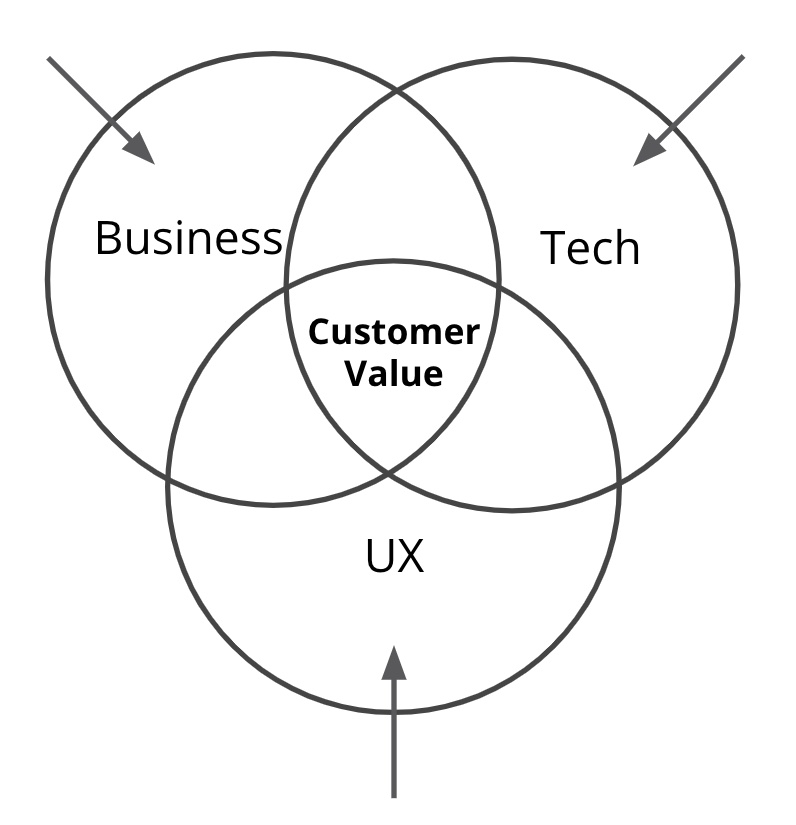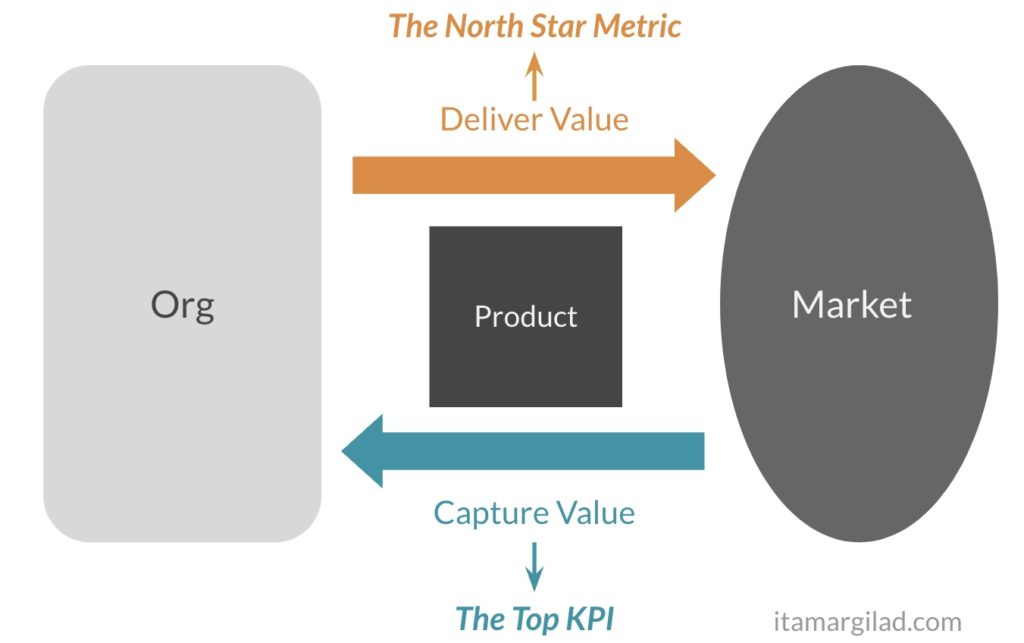In a famous essay Martin Eriksson defined product management as “the intersection between the functions of business, technology and user experience.”

While it’s flattering to imagine ourselves as the center of things, it’s also a strange way to define a role. Why do we need a function in an organization that is a composite of other functions?
The reason is that the people that occupy UX, tech and business roles are specialists. They go to different schools, practice different methodologies and processes, and contribute to success in different ways. This specialization is powerful, but it can also lead to misalignment — each discipline may try to pull the product in a different direction, one that is valid, but not necessarily optimal. Add siloing, middle-managers, and departmental goals, and you have a recipe for a product that goes nowhere.

So we add product managers in the middle— generalists who speak all three languages (very hard to hire, by the way), yet wear none of the hats, and manage no one. Does that solve the problem?
In a word, No. Usually it doesn’t.
Product managers that act as middlemen who broker a compromise, or as enforcers of top-down decisions, are at most painkillers. As long as the organization is fundamentally misaligned, the product (and product managers) will have to withstand a lot of pressure. With enough legwork, negotiations, and good old top-down decisions, it’s possible to arrive at a “roadmap” but it’ll be a compromise, and no one will be truly happy. The product will not follow any clear long-term strategy and progress will be slow and erratic.
True product management (which actually extends beyond product managers) requires another crucial element, one that Amazon, Google, Apple, Netflix, and practically every successful tech company you know, is using. That is to have all disciplines converge around a common top goal; something that business, tech, and UX can all agree is of the highest importance.
This thing is customer value.

(To clarify, by customer value I mean value delivered to customers, not the value of a customer.)
Why customer value and not revenue, net income, paying customers, or other business goals? Because customer value underlies all of these. As any good sales rep or marketer will tell you, building high value products is the best thing you can do for your business. High-value products are much easier to market and sell, customers are willing to pay more for them and retain better. High-value products also create strong word-of-mouth and brand loyalty, and keep competitors at bay. Optimizing for high customer value is optimizing for business success.
Most engineers and designers will intuitively agree. They get into the profession to make a difference in other people’s lives. But for business folk, customer-value sounds like an unobvious choice. We’re used to driving business teams towards short-term acquisition, revenue, and profit goals. The result is often so-called coin-operated sales reps and mercenary marketers — people who will stop at nothing, including compromising the long term benefit of the customers and the product, to make their numbers. But that is a result of a shallow, even misguided interpretation of these roles. Marketing and sales are at the vanguard of value creation. They bring the product to the attention of the customers, inform them of the benefits, help them experience the value first-hand, smooth the way for adoption, and manage the relationship. Good sales and marketing professionals care deeply about their customers and take pride in the joy they’re able to bring them. They try to cater to customer needs, before, during and after the sale. It’s just good business. As marketing guru Seth Godin put it, “It’s easier to love a brand when the brand loves you back.” Customer-facing people are in the best position to show this love.
Sign up to my newsletter to get articles like this (plus eBooks, templates and other resources) in your inbox.
Making Customer Value The Top Objective
In good technology companies customer-value is baked into everything, starting with the mission. The cliched “become a leader in X” is chucked away in favor of statements like “Organizing the world’s information and making it universally accessible and useful” (Google), “Connect the world’s professionals to make them more productive and successful| (LinkedIn), and “Unleash the potential of every team” (Atlassian). The mission calls out the core value we wish to create for our users and customers. Everyone (business teams included) is expected to take the mission to heart and make customer-value the top priority. At Amazon people are literally asked to “obsess over customers”.
The next step is to quantify the mission — to express it in metrics we can measure and track. There will be a number of important metrics, but for simplicity and memorability, we often strive to pick one that is of the highest importance. A number that approximates the total value we create for our customers. This metric is commonly called the North Star Metric (NSM), because it serves as the guiding light for the product, and often for the entire company. I’ve written about the north star metric before, but just as a refresher here are some examples:
- WhatsApp — Messages sent
- YouTube — Minutes watched
- eBay — Gross merchandise volume (GMV)
- Airbnb — Nights booked
Note how none of these metrics is perfect, yet they all generally capture how much value we deliver to the market. If the number of messages sent through WhatsApp grows year-over-year from 1Bn to 2Bn, we can roughly say that the company doubled the amount of value it created. Note also how simple and memorable these metrics are. This is by design — It’s hard to guide people with a complex formula.
But (and this is a really big But) as growth guru Sean Ellis points out: while the north star metric is our most important metric, it is not the only metric that matters. We need to track many other metrics, including ones that are about the value the company is capturing back from the market. For starters I recommend that each company will pair its north star metric with a top-business KPI – a metric that measures the total value the company wishes to capture from the market. Typically this is some form of revenue, profit, or number of paying customers. Together these so-called impact metrics measure the core value exchange between the company and its market.

Aligning Customer Value with Business Value
Let’s look at an example. Say Blue corp is developing a productivity suite for enterprises. The north star metric is the number of documents created per month, because the company believes that each document created delivers a small increment of value to a user. The top business metric is revenue, because the company needs to hit a particular revenue target this year to close the next round of investment. The two top metrics communicate clearly what the company considers most important. Here they are side-by-side:

At first glance they seem unrelated or even conflicting. Theoretically we can give the product away for free, and have customers create lots of documents. Or we can boost short-term revenue by committing to deal-closing features at the expense of features that more broadly address users’ needs. However both of these approaches are not sustainable over the long term. Sustainable growth means finding a win-win formula where both value delivered and value captured grow in lock step. The NSM and top-business-metric should be made co-dependent so we can achieve a virtuous loop of growth.
To find how our top metrics are related, we can look at sub-metrics (aka input metrics) that influence them (typically these form a metrics tree).
For example:
- Document created per month = Monthly active users (MAU) * documents created per user per month
- MAU = # of paying customers * MAU per customers
- Revenue = Monthly Rev from new customers + Monthly Recurring Rev
- Recurring rev = MAU * average monthly recurring fee
These simple formulas illustrate some basic realities of the business:
- A key way to grow the number of documents created per month (the NSM) is to sell more licenses
- A key way to grow revenue (the top KPI) is to develop a sticky product that gets customers to retain.
You can see how these statements help align business and product. Engineers and designers should see the importance of closing sales, sales reps and marketers should see why creating a generally-useful product helps grow revenue (more than developing one-of features for individual customers).
We go deep on topics like these in my Lean Product Management workshops.. Secure your ticket now to the next public workshop or contact me to organize an in-house workshop for your team. For more info see itamargiladcom/workshops.
Transforming into a Customer-Focused Company
Many companies pay lip-service to customer-focus, but are actually narrowly focused on their own needs and those of their shareholders. The mission is about market leadership, the key metrics are revenue, profit, and share price. The only customer-focused(-ish) metric is Net Promoter Score (NPS), and even that is asking the question whether customers will recommend our product to others. For these companies, the customers are assets to capture and to protect, nothing more.
If you wish to transform and to modernize the way you create products, this is the place to start. Put aside classic business management thinking and put the customer at the center of everything. Doing this will allow you to utilize product management to its fullest, and to create better products. It will improve your company, aligning people and giving them a shared sense of meaning. In a world where customers have a lot more choice and freedom, customer-focus is the surest path to business success.
Photo by Jose De Queiroz on Unsplash.

